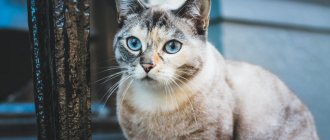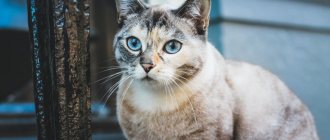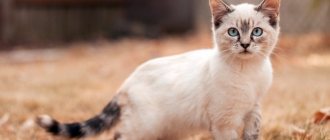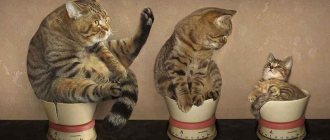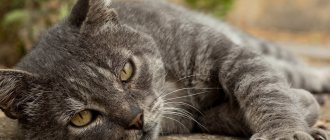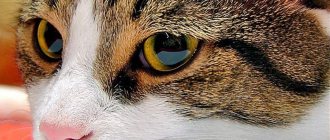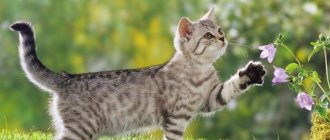Why do you need to know the age of cats?
Having found out how old your pet is, you can properly adjust its care, balance its diet, and better monitor its health. It is impossible not to take into account changes in years, because this will have a bad effect on the standard of living of your mustachioed friend. Why else might such knowledge be useful:
- Determine the level of physical activity, the intensity of which decreases with age. Excessive play with an elderly person will have a bad effect on the joints and cardiovascular system. But for younger people, lack of activity will negatively affect physical development or lead to dangerous obesity.
- The cat's health is monitored in accordance with physiological changes. For example, only older individuals are susceptible to cataracts. Therefore, caring for mature pets should be more thorough.
- The selection of diet must be correlated with the characteristics of the period of life. Nutrition must meet the needs of the body. For example, older cats find it difficult to eat dry food because their teeth have worn out and become more brittle. They are no longer adapted to rough food.
Knowing the degree of maturity, it is not difficult to help your mustachioed friend develop fully and provide him with good care and proper nutrition. The quality of life and attention of the owner will prolong the cat’s life.
Elderly (15-19 years old) and old age (over 19 years old)
If you monitor your cat’s health, then even in old age (15-19 years) he will be quite vigorous, resembling a person from 60 to 75 years old. Of course, the cat’s activity will decrease, his habits and daily cycles will begin to change, and he will require more careful and attentive care.
Read about caring for an elderly pet: Features of caring for old cats
We would be lying if we say that a cat after 17-18 years can be completely healthy. In the end, sooner or later a person inevitably begins to have health problems. But even in these years, the owner and the pet can give each other joy, good care, attention and care can make the last years of the pet easier and delay the inevitable death, ideally closer to 23-25 years. And the record-breaking cat, by the way, lived for 38 years!
Tables of a cat's age by human standards
This technique was developed by zoologists and veterinarians. The basis is a coefficient that takes into account not only the physiological development, but also the psychological and intellectual level of the animal at each stage of life. On this basis, a table has been compiled that allows you to approximately find out the relationship between the age of a cat and human ideas.
Be sure to read the article to the end, in it we will tell you how to accurately compare a cat’s age with a human’s. Let's talk about other ways.
Kittens up to one year:
| Animal age (months) | Similar human age (years) |
| 1 | 0,5 |
| 2 | 1 |
| 3 | 2 |
| 4 | 6 |
| 5 | 10 |
| 6 | 13 |
| 12 | 18 |
Adult cats and female cats:
| Animal age (years) | Similar human age (years) |
| 2 | 25 |
| 3 | 32 |
| 4 | 35 |
| 5 | 40 |
| 6 | 43 |
| 7 | 46 |
| 8 | 50 |
| 9 | 55 |
| 10 | 60 |
| 11 | 64 |
| 12 | 67 |
| 13 | 70 |
| 14 | 72 |
| 15 | 75 |
| 16 | 76 |
| 17 | 78 |
| 18 | 83 |
| 19 | 91 |
| 20 | 100 |
Although this definition is closest to the truth, it must be remembered that it is impossible to accurately compare human and cat ages due to their fundamental differences in development as biological species.
How cats grow up
Cats behave differently at different stages of their lives. It is behavioral and physical changes that make it possible to compare the stages of life with human ones and derive the ratio of the age of a cat and a person.
It is interesting that all representatives of the cat family mature in the same way, that is, there are no noticeable differences between breeds, as, for example, in dogs.
Infancy and childhood
Due to genetics and a unique metabolism, cats mature faster. In the first 6 months they make a leap of 10 human years.
- Born blind and defenseless, the kitten changes every day. Within a week, hearing appears and the eyes open. In the second week, baby teeth emerge. For comparison with a human baby, this occurs at 5-8 months.
- At 1 month, kittens are active, which can be compared with a human child aged 1-1.5 years.
- In terms of social behavior, a 3-month-old kitten is comparable to a two-year-old child.
- At 4-5 months, the kitten already takes care of itself, can feed itself (without its mother), plays with other kittens and determines who is its own and who is a stranger. Based on the table, this time is equivalent to a 9-10 year old child. It turns out that a six-month-old kitten is a child in elementary school. He is very active and curious. Therefore, the owner’s task is to work on raising the kitten, instilling in it good habits: do not tear up furniture and wallpaper, go to the toilet only in the litter box, do not chew wires.
Stages of a cat's life
According to scientists, a cat’s life goes through six age stages:
- Childhood (from birth to 6 months) is a stage of rapid growth and development until the onset of puberty.
- Youth (from 6 months to 2 years) – preparation for adulthood; growth continues, but its pace is decreasing.
- The prime of life (from 2 to 7 years) is the peak of physical and mental activity: the cat has strong bones, teeth and beautiful healthy fur.
- Maturity (from 7 to 11 years) – a slight decrease in activity.
- Old age (from 11 to 15 years) – gradual loss of vitality, which affects the condition of the coat, claws and teeth; occasionally health problems.
- Old age (over 15 years) – decreased activity, increased sleep duration, greater risk of disease.
Adolescence (6 months – 1 year)
At this time, the kitten is a real teenager by human standards. Continues to grow actively, although it is already beginning to resemble an adult. He has even more energy than before, he needs no less attention, and his character may begin to emerge. Interest in the opposite sex appears. This is the best time to spay or neuter your pet. These procedures are completely safe and will only save your pet from health problems, and you from headaches due to cat cries during hormonal peaks and/or the placement of offspring.
Read more: At what age are cats spayed?
Physiological signs of a cat's age
It happens that an animal ends up with owners who are not aware of how old it is - for example, from a shelter or straight from the street. In such cases, veterinarians pay attention to the condition of the animal’s teeth to determine its approximate age:
- At 1 month the kitten has all its milk teeth.
- By 6 months they are completely replaced by native ones.
- By the middle of the second year of life, the central middle incisors are slightly worn down.
- By the age of two and a half, the lower middle incisors begin to wear off.
- At three and a half years, this also happens to the central teeth of the upper jaw.
- In another year - with the average ones.
- By the age of five, the fangs begin to suffer.
- By six – the outermost upper incisors.
- By nine, all the teeth in the lower jaw have been ground down.
- And by ten - the top one.
- By twelve, the central incisors may begin to fall out.
- Some cats lose most of their teeth by age fifteen.
These parameters are highly dependent on breed, heredity and health. You should also take into account how and what the animal eats, what conditions it lives in, and whether it receives vitamin and mineral supplements that help protect teeth from age-related changes.
Why do you need to determine the age of a kitten?
Kittens of different ages require different care
The appearance of a kitten in a person’s life is not only joy, but also responsibility. A kitten can end up in a new home in different ways; you can take it from a nursery or pick it up on the street. If in the first case the owner learns the age of the kitten from the breeders, then in the second case it will not be known reliably. So how and why should we determine the age of a street kitten?
The main reason is the difference in kitten care depending on their age. Starting from food to necessary vaccinations. Improper care of a kitten can disrupt its development and cause diseases.
Age comparison principles
There is an opinion that in order to calculate the age of a cat by human standards, it is enough to multiply it by seven. In fact, this approach is only valid for animals between three and ten years of age.
They grow up and grow old at a completely different pace than humans.
It is necessary to take into account the principles of recalculation:
- There is no calculation formula for cats under three years of age.
- A three-year-old animal reaches approximately the same degree of development as a person at 25-30 years old.
- From three to five years, this figure increases by 7 every year.
- From five to twelve years – by 4.
- After twelve years, each year is counted as 3.
We recommend reading: Allergy to cats: symptoms and treatment for children and adults
How to determine more precisely?
Feline scientists have been researching this issue for many years and managed to create a table that shows the relationship between the stages of cat development relative to human ones. Using this calculator, you can more accurately calculate the human age of an animal.
When examining the data in the table, it becomes clear that in the first year of its life, a cat learns about the same amount about itself as a human cub does in its fifteen years. Only the second year has passed, and your cat will definitely be sold alcohol and allowed into the club - after all, consider 24. After the second year, development slows down, there is nowhere to rush, it makes sense to enjoy youth and activity.
Each subsequent new year adds only 4 years to your pet’s internal age. Thus, a sixteen-year-old cat is already an eighty-year-old old lady.
How is a cat's age calculated by human standards?
- 1 year of a cat - 15 years of a human;
- 2 years old cat - 24 years old;
- 3 years - 28 years;
- 4 years - 32 years;
- 5 years - 36 years;
- 6 years - 40 years;
- 7 years - 44 years;
- 8 years - 48 years;
- 9 years - 52 years;
- 10 years - 56 years;
- 11 years - 60 years;
- 12 years - 64 years;
- 13 years - 68 years;
- 14 years - 72 years;
- 15 years - 76 years;
- 16 years - 80 years.
Now that it is clear how to calculate the age of your pet, you can see that such a table is far from the only one. Instead of simple numbers, it is much more interesting to divide a pet’s life into stages, like a person’s: infancy, childhood, teenage crisis, youth, maturity, old age. But seriously, scientists have already divided it, and there are 6 such stages.
How to determine how old a cat is
By some external signs you can easily determine the age of a cat. For example:
- Tough . After three months of life, kittens' milk teeth are replaced with permanent teeth. For up to one and a half years, cats and kittens retain the white color of their teeth, after which the tooth enamel begins to turn yellow. After 3 years of life, tartar begins to appear on the animal’s teeth. After ten years of life, the central, middle, and then the outer incisors begin to fall out. By the age of 15, a pet's fangs will fall out.
- By puberty . Males and females become sexually mature after six months of their life. It is during this period that they begin to mark the territory with a secretion that has a very unpleasant odor.
- According to the nature of the coat . Younger animals have soft and thin coats, compared to older animals whose coat becomes coarse and becomes lighter or darker. In an older animal, you can already see something like gray hair, which appears in the form of individual hairs or entire lightened spots.
- By the eyes . Young cats and cats have fairly clean and clear eyes, which cannot be said about older animals whose eyes become cloudy with obvious signs of pigmentation disorders within the irises.
To more accurately determine the age of animals, there are a number of formulas and tables.
| Age of the cat | Person's age |
| One year | 7 years |
| Two years | 14 years |
| Three years | 21 years old |
| Four years | 28 years |
| Five years | 35 years |
| Six years | 40 years |
| Seven years | 45 years |
| Eight years | 50 years |
| Nine years | 55 years |
| Ten years | 60 years |
| Eleven years | 65 years old |
| Twelve years old | 70 years old |
| Thirteen years | 75 years old |
| Fourteen years old | 80 years old |
| Fifteen years | 85 years old |
| Sixteen years | 90 years old |
| Seventeen years | 95 years old |
| Eighteen years | 100 years |
Which information is more accurate?
According to many experts, the information given in the following table is considered the most accurate.
| Age of the cat | Person's age |
| One year | 15 years |
| Two years | 24 years old |
| Three years | 28 years |
| Four years | 32 years old |
| Five years | 36 years |
| Six years | 40 years |
| Seven years | 44 years old |
| Eight years | 48 years old |
| Nine years | 52 years old |
| Ten years | 56 years old |
| Eleven years | 60 years |
| Twelve years old | 64 years old |
| Thirteen years | 68 years old |
| Fourteen years old | 72 years old |
| Fifteen years | 76 years old |
| Sixteen years | 80 years old |
| Seventeen years | 84 years old |
| Eighteen years | 88 years old |
| Twelve years | 92 years old |
| Twenty years | 96 years old |
Each cat breed has its own life expectancy data. For example:
- The Snowshoe breed lives on average about 11 years.
- The Bombay cat can live for at least 12 years.
- The Russian Blue cat lives for at least 13 years, as does the American Bobtail.
- Scottish Straights, Rex cats and York chocolate cats reach an age of about 14 years.
- Sphynxes, Persian cats, as well as the Abyssinian cat and the British Shorthair live up to the age of 15 years.
- The Maine Coon breed lives no more than 16 years.
- The Australian Smoky and Neva Masquerade will live at least 17 years.
- Cats such as Tiffany and Japanese Bobtail will live about 18 years.
- An Asian tabby can live for about 19 years.
- The American Shorthair and Manx live within 20 years.
Cat breeds such as Thai and Siamese are also long-lived.
Translation methods
The topic of converting cat years to human years is relevant, therefore, many ways have been invented in the world to calculate the age of a cat and convert it.
Method 1
The most widely accepted belief is that each year of a moustached animal’s life is equal to 7 human years. However, this is not true; in fact, cats mature and age much faster in the first 2 years of their life. Then the aging process slows down. Therefore, this method should be classified as a myth from a cat’s life.
Method 2
There is a version according to which, in order to convert a cat’s age to a human’s, you need to multiply it by 5. This is also incorrect. The fact is that in the first year of life in cats, infancy, childhood and adolescence occur.
Method 3
Third technique:
- The first year of a cat’s life is equivalent to that of a teenage human, namely 14-15 years.
- By the age of 2, a cat’s character is fully formed, as is its physical form. Therefore, a match is made between a two-year-old cat and a person who has turned 24.
- After the 3-year mark, each cat year is equal to 4 human years.
The conversion formula is:
Age of the cat in h.g. (human years) = 24 + (cat's real age – 2) * 4.
Calculation example:
- Masa the cat is 7 years old.
- This means that if he became a man, then 24 + (7-2) * 4 = 44.
Answer: Masya is 44 years old in human terms.
Method 4
The fourth translation formula applies only to animals aged 2 years and older. It is considered the most accurate:
Human age of a cat = number of years at the time of counting * 4 +16
Below is the data calculated using this formula.
Table comparing the age of a cat by human standards:
| Life stages | Animal age | In human equivalent (in years) |
| Kitten (from birth to 6 months) | 0-1 month | 0-1 |
| 2-3 months | 2-4 | |
| 4 months | 6-8 | |
| 6 months | 10 | |
| Teenager (7 months – 2 years) | 7 months | 12 |
| 1 year | 15 | |
| 1.5 | 21 | |
| 2 | 24 | |
| In bloom (3-6 years) | 3 | 28 |
| 4 | 32 | |
| 5 | 36 | |
| 6 | 40 | |
| Mature (7-10) | 7 | 44 |
| 8 | 48 | |
| 9 | 52 | |
| 10 | 56 | |
| Elderly (11-14) | 11 | 60 |
| 12 | 64 | |
| 13 | 68 | |
| 14 | 72 | |
| Elderly (15+) | 15 | 76 |
| 16 | 80 | |
| 17 | 84 | |
| 18 | 88 | |
| 19 | 92 | |
| 20 | 96 |
To calculate how many human years a cat has celebrated its 20th birthday, you need to add 4 for each subsequent year.
Lifespan of cats and its extension
There is a pattern in nature: the smaller the animals, the shorter their life span. Cats are an exception in this regard - they live relatively long for their size. They usually manage to live to be fifteen to twenty years old.
The oldest one, according to the Guinness Book of Records, is 38 years old (about 145 years old by human standards).
Among the factors on which the longevity of these animals depends are the following:
- Breed. For example, Snowshoes live on average 11 years, American Bobtails - 13, Scots - 14, Persians, Sphynxes and British - 15, Maine Coons and Kuril Bobtails - 16, Tiffany - 18. Siamese, Thais and American Shorthairs, which often live up to 20 years.
- Lifestyle. Movement is a very important need for an animal. Passive pastime shortens his life.
- Nutrition. An unbalanced diet negatively affects the general condition of the body. Both a deficiency and an excess of certain substances have a negative impact.
- Sexual activity. Unsterilized cats and cats must have the opportunity to realize their sexual instincts - otherwise the hormonal balance in the body is disrupted.
- Psychological condition. Stress and emotional stress lead to neuroses and shorten life.
We recommend reading: To what age do cats and female cats grow?
Based on this information, several simple principles of longevity can be identified: a balanced diet, an active lifestyle, a psychologically safe environment, sterilization if necessary and timely visits to the veterinarian.
According to research, the aging process in cats begins after about four years of age. Despite this, many animals feel great even in old age and remain active.
However, sooner or later, old age takes its toll, and owners begin to be interested in the issue of extending the life of their pet.
It is possible to slow down this process if you follow seven simple recommendations:
- Do not feed the animal “from the table”, use specialized complex feed of the highest quality. Give preference to poultry and lean beef. If the cat is accustomed to homemade food, the transition should be smooth.
- Do not give milk: it is contraindicated in adult cats because they do not produce the enzyme to digest it.
- Organize a proper diet, especially if the animal is prone to obesity. Avoid overeating.
- Provide the cat with conditions for active play and take walks outside.
- Maintain hygiene: periodically clean ears, eyes and teeth, comb out fur.
- Carry out prevention against parasites using anthelmintic drugs and anti-ectoparasites.
- Visit the veterinarian and get the necessary vaccinations.
Youth (1 year – 4-5 years) and youth (4-5 – 10 years)
By about 1.5 years, the cat finally grows up, now he is no longer a kitten, but an adult pet, although by both cat and human standards he is still very young. He will still play frequently and actively and demand your attention, but his daily routine will begin to stabilize. Now it is enough to feed him 2-3 times a day (observing the norm, of course); in the absence of health problems, visits to the veterinarian can be reduced to once a year for a routine examination and vaccination.
In general, this rhythm of life can be maintained for up to 10 years - with good care, which implies the absence of uncontrolled walking on the street, high-quality nutrition, disease prevention, treatment for parasites, timely treatment, attention and love from the owner.
Read more about what affects life expectancy: How many years do cats live?
With proper care, a 9-10 year old cat can be compared to a 40 year old person leading a healthy lifestyle. It’s not that he can’t have fun like an 18-year-old, he quite can, he just doesn’t consider it necessary to do it as often. The same applies to cats: yes, they are usually calmer, but offer them an interesting game, and you will see that they frolic no worse than kittens.
Do you remember that we started with the fact that at this age some already consider a cat to be an “old lady”? You won’t be surprised by the words that for a 40-year-old man, all the most important things, both personally and professionally, are still ahead?! Conversely, it will probably seem strange and incredibly rude if someone says that this person is “going to die.” But a 10-year-old cat, by human standards, is just such a person!
Therefore, it is very important: if a pet at 8-10 years old becomes lethargic, apathetic, and begins to refuse food, then this does not indicate old age, but some kind of disease. You need to take him to the vet immediately, and then he will stay with you for many more years.
What can negatively affect a cat’s “human” age?
Of course, the above figures may differ from reality. All cats are different, and their lives also depend on their owner. Plus, different breeds have different life expectancies, which means the conversion factor into human years is also different.
That is, the human age of an individual cat may depend on factors such as breed, living conditions, quality of nutrition, previous diseases, etc.
Some things, of course, will remain unchanged, for example, the period of growing up and maturation. For animals such as cats, it is important that this period passes as quickly as possible. In nature, a lot depends on this - the survival of an entire population. This means that the first two years of your cat's life will definitely be the fastest, most active and filled with various events. But the rest of her life largely depends on you.
What affects a cat's lifespan?
The age of a cat is influenced by many factors. Not all of them can be made positive by the owner. But most can be corrected by the owner. What makes up a long and happy cat's life?
- Minimizing stress. For cats, these are different events: moving, the arrival of a new person or pet in the house, a new owner, illness. You can prepare for many events in advance, give you calming drops, and help you adapt to a new territory.
- Proper nutrition. Undoubtedly, species-typical food is more suitable for a domestic predator. Cats have been eating this way for thousands of years, naturally and naturally.
- Active lifestyle. Health is directly affected by how much our furries move. Mobility is important for joints, internal organs, metabolic processes, and a stable mental state. If your cat tends to spend time sleeping, offer her active games, new toys, and go for walks. Equip a complex and climbing frames for your pet.
- Walking is under control. Unfortunately, cats that walk on their own live shorter lives. A sharp car horn, evil people, dogs, viruses, poisoning - all this awaits a cat outside the threshold, no matter how smart and quick-witted it is. Walking on a harness is ideal.
- Preventive examinations. Visit the veterinarian once a year, vaccinate your pet, and take the necessary tests. After 7 years or in case of a chronic disease, it is recommended to undergo examinations more often, once every six months.
- Sterilization and castration. This significantly reduces mammary gland tumors in cats and prostatitis in cats. There is no unnecessary stress due to estrus, and there is no need to use dubious anti-estrus remedies. But before sterilization, conduct examinations.
How long and how a cat will live depends directly on the owner.
Of course, the owner's love and affection directly affect the mental and physical state of the cat. Animals that are cared for and their needs met live longer.
Determining the number of years lived
It is difficult for an inexperienced owner to determine the age of a cat without the help of a specialist. An experienced breeder is able to accurately indicate the age of his pet, but it would be best to show the animal to a veterinarian. The specialist will not only tell you how old the cat is, but will also paint a general picture of her condition. In veterinary practice, there are several criteria for determining the age of animals.
According to the condition of the teeth
Veterinarians can easily determine the amount of time an animal has lived by looking at its teeth. This method is effective for different individuals, from kittens to old people. This fact can be explained by the fact that the schedule for replacing baby teeth with molars is quite strict. The strength of the fangs and their color are the best indicators of not only the health of the pet, but also its maturity.
| Number of years | Condition of the oral cavity |
| 5 weeks | Baby teeth erupting |
| 6 months | Dairy products are completely replaced by permanent indigenous ones. |
| 1 year | The canines should be in the best condition, white and strong |
| 1.5 years | The incisors on the lower jaw begin to wear off |
| 2 years | The enamel becomes yellow in color and traces of deposits appear |
| 4-5 years | The incisors on the lower jaw wear away very noticeably |
| 6 years | Abrasions on the fangs begin to appear, dark spots appear on the enamel |
| 7 years | The surviving incisors are completely worn away. Fangs in poor condition |
| 10 years | Half of the teeth are lost |
| 13-15 years old | Fangs fall out |
Table 1. Age of cats according to dental condition
The influence of time lived on the condition of the oral cavity is very noticeable. Unfortunately, the owner rarely pays attention to this and is in no hurry to change the pet’s diet when necessary. It would be a good idea to make periodic visits to a veterinarian-dentist, who will assess the condition of the oral cavity and tell you how to prevent teeth from wearing out too early.
According to the condition of the coat
The pet's appearance helps determine a cat's age. This method of definition is the most understandable for a non-specialist. However, veterinarians do not consider this method to be unambiguous, because environmental factors and living conditions can affect the condition of the coat and skin. Good care plus a balanced diet allows you to maintain an excellent appearance even in older individuals. There are only generalized signs that help determine the degree of maturity of a pet.
| Number of years | Type of coat |
| 0-1 | Hair is soft and shiny. There are no signs of baldness or tangles |
| 1-7 | A healthy individual has fur in excellent condition: smooth, fluffy, with a good pattern. Gray hair is completely absent |
| 8-15 | The hair is dull and thin. Tangles and bald spots often appear |
We recommend reading: Protection from a dog in the event of an attack: stun gun and other means
Table 2. Age of cats according to coat condition
This method of determination has many disadvantages. Representatives of some breeds have no hair at all or their hair is quite short and coarse. This makes it much more difficult to figure out changes over the years.
Long-lived cats: records, breeds
Long-lived cats can live 29 years, which has documented evidence. But there are cats that lived longer and are listed in the Guinness Book of Records:
- Cream Puff from Texas (08/03/1967 - 08/06/2005), 38 years, 3 days.
- Sphynx Granpa Rex Allen, a hybrid of Sphynx and Devon, from Texas, although he was born in Paris (02/01/1964-04/01/1998), 34 years, 2 months.
Both animals lived with Texan Jake Perry. It is believed that the long life of these animals in one owner is explained by their diet: bacon, broccoli, eggs, asparagus.
But the oldest cat is considered to be Lucy, Lower Wales, England. Her age cannot be confirmed with absolute certainty. This is an ordinary yard cat, whose age its new owner tried to determine after the death of its owner. He found witnesses who confirmed that the cat was born in 1972 and in 2015 she was 43 years old.
How to extend the life of cats?
During the growth and development of an animal, it is accompanied by various ailments. As a rule, they are all associated with poor nutrition, a sedentary lifestyle, and a lack of vitamin and mineral components, which leads to negative consequences and a reduction in the life expectancy of pets.
Interesting information! According to scientists, the natural processes of aging in cats begin already in the fifth year of life, which is associated with a weakening of the functions of the immune system and a reduction in the intake of antioxidants.
Based on this definition, there are ways that can extend the life of cats. Such decisions should include:
- Pets should be fed exclusively with healthy and nutritious food products, as well as premium store-bought food.
- Get vaccinations recommended by specialists in a timely manner, and also visit your veterinarian regularly.
- A pet should be in constant motion, regularly visiting the street.
- Regularly prevent infection of domestic animals with ectoparasites and worms.
- Constantly monitor the condition of the skin, coat, as well as the eyes, ears and teeth of your pet.
- If the animal is not intended for breeding work, then it must be castrated or sterilized in a timely manner.
- After six months of life, large amounts of milk should be excluded from the cat’s diet, as this promotes the production of lactase.
- The diet should include a sufficient amount of raw meat, but only high-quality meat in the form of lean beef or chilled poultry.
- Do not practice sudden transitions from one type of nutrition to another.
- Do not allow your pet to constantly overeat, otherwise this can lead to obesity and further heart problems, constipation and diabetes.
Organizing proper nutrition for a pet using only high-quality food or ready-made diets, along with care and love for the pet, are the fundamental factors that have a major impact on the life expectancy of cats.
At specialized retail outlets you can purchase factory-made, ready-made food rations that are balanced in terms of vitamins and minerals. There are brands of diets that have proven themselves well and are very popular. These are diets such as ProPlan, Brit Premium and Brit Care, Royal Canin, Hills and others. In any case, you can get comprehensive information from the sellers of this product.
When feeding your pet with natural foods, you should not feed certain foods from the table, such as fried, salted or pickled foods, sweets, including baked or flour products.
It is strictly forbidden to give cats or add various flavorings, flavor enhancers or seasonings to products intended for feeding cats. Particular attention should be paid to the diet used to feed spayed or neutered animals, as well as those animals that have any health problems.
Sources
- https://kinpet.ru/vozrast-koshki-v-sootvetstvii-s-chelovecheskim-raschety-i-tablitsy/
- https://MrKot.com/vozrast-po-chelovecheskim-merkam
- https://catshere.ru/vozrast-koshki-po-chelovecheskim-merkam.html
- https://68koshek.ru/fiziologiya/vozrast-koshki-po-chelovecheskim-merkam
- https://heaclub.ru/kak-opredelit-poschitat-vozrast-koshki-kota-po-chelovecheskim-merkam-raschet-tablica-vozrasta-koshek-i-cheloveka-skolko-let-zhivut-koshki-koty-po- chelovecheskim-merkam-kak-opredelit-biologiches
- https://faunistics.com/skolko-koshke-let-po-chelovecheskim-merkam/
[collapse]
How lifestyle affects a cat's longevity
To prolong the life of a pet, it is necessary to create the most favorable conditions for it, such as:
- Balanced food;
- A cozy and warm place to relax and sleep;
- Avoid physical and psychological harm;
- See a veterinarian regularly;
- Protect the animal from all unfavorable factors that can shorten the cat’s life (for example, solve the problem of stress during the mating season).
It is important to know that castrated cats and sterilized cats live, as a rule, longer than individuals who take part in procreation.

